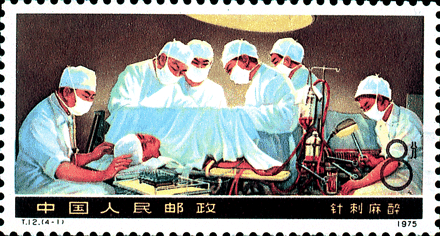Acupuncture anaesthesia for open heart surgery
Open heart surgery under acupuncture anaesthesia is depicted on this 8 cent Chinese stamp issued in 1975 as part of a set of four stamps to commemorate the successful integration of traditional Chinese medicine and modern Western medicine in the treatment of various diseases. The four Chinese characters at right lower corner of the stamp stand for acupuncture anaesthesia. The other three stamps in the set feature such surgical feats as replantation of severed limbs, application of small soft splints for fractures, and cataract surgery.
The patient in this stamp was a 15 year old girl with congenital ventricular septal defect. The Chinese made disc oxygenator for total cardiopulmonary bypass can be seen on the right. The anaesthetist who performed the acupuncture—two fine needles inserted in both wrists and a further two in the anterior chest wall at both subclavicular areas—was at the patient's head; he was a practitioner of Chinese traditional medicine. The surgeon on the patient's left was Professor Yi-shan Wang, my schoolmate in St John's University School of Medicine, Shanghhai, China, and the surgeon on the patient's right was Dr Chun-xiu Yeh, my classmate in the same school.

From the historical record of Huangdi Neijin (The Yellow Emperor's Classic), acupuncture has been used in China as a therapeutic measure for at least 2000 years.1However, acupuncture as anaesthesia is a relatively recent development. It has a sound physiological and neurochemical basis.1Although acupuncture anaesthesia is still widely used in China for craniotomy and thyroidectomy, it is not as frequently employed today for open heart operations in China as it was in the 1970s. The main reason is that the patients have to undergo lengthy preoperative training to practice slow and deep abdominal and diaphragmatic breathing required during the operation to overcome the positive atmospheric pressure in the event that the pleural cavity is inadvertently entered; another prerequisite is that the surgeons must be extremely gentle, meticulous, and speedy. Conventional anaesthesia obviates both of these requirements and is thus preferred by younger surgeons.
There is a phrase in Chinese shown on the stamp,
 , which means “being happy”. Literally translated, Kai Xin actually means to
open the heart. This remarkable stamp certainly depicts such a happy moment
in the history of Chinese cardiac surgery. To transform acupuncture from a
form of traditional medicine for relief of pain to a form of anaesthesia for
open heart surgery is truly a great leap forward.
, which means “being happy”. Literally translated, Kai Xin actually means to
open the heart. This remarkable stamp certainly depicts such a happy moment
in the history of Chinese cardiac surgery. To transform acupuncture from a
form of traditional medicine for relief of pain to a form of anaesthesia for
open heart surgery is truly a great leap forward.